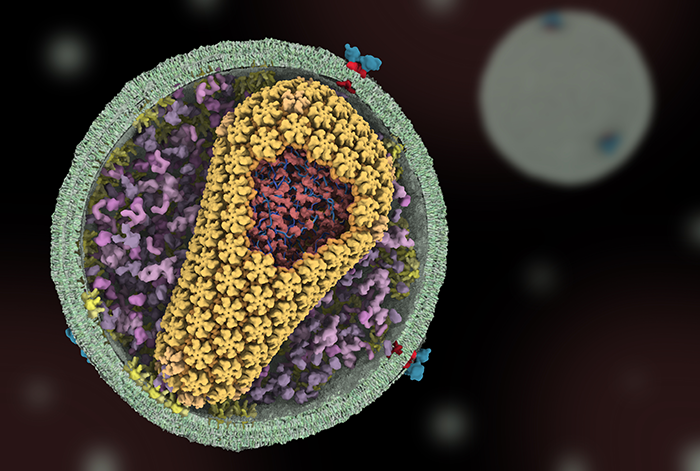![Human immunodeficiency virus (HIV). Outer membrane (green) is dotted with proteins (red, blue) essential for recognizing and fusing with host cells. Inside are structural proteins and enzymes (purple). Capsid (orange) houses RNA (blue) that enables HIV to replicate in host cells, along with protective proteins (red). [Janet Iwasa/University of Utah/NIH]](https://genengnews.com/wp-content/uploads/2018/08/hivinfectionmodel8794222113-1.png)
Human immunodeficiency virus (HIV). Outer membrane (green) is dotted with proteins (red, blue) essential for recognizing and fusing with host cells. Inside are structural proteins and enzymes (purple). Capsid (orange) houses RNA (blue) that enables HIV to replicate in host cells, along with protective proteins (red). [Janet Iwasa/University of Utah/NIH]
There is a philosophy that ascribes to the notion that for every disease humans have encountered, nature has already devised a cure—we need only find it. A group of scientists from the University of Illinois at Chicago (UIC), Hong Kong Baptist University, and the Vietnam Academy of Science and Technology, working together as an International Cooperative Biodiversity Group (ICBG), may have just taken a step closer to proving the philosophy true. The research team has just published data describing that a plant found throughout Southeast Asia traditionally used to treat arthritis and rheumatism contains a potent anti-human immunodeficiency virus (HIV) compound more powerful than the drug azidothymidine (AZT).
Findings from the new study were published recently in the Journal of Natural Products in an article entitled “Potent Inhibitor of Drug-Resistant HIV-1 Strains Identified from the Medicinal Plant Justicia gendarussa.”
The inhibitory compound, called patentiflorin A, was derived from the willow-leaved Justicia plant and was identified by screening thousands of plant extracts for their effect against the HIV virus. The ICBG team discovered the molecule in their search or natural products that may have applications in health and medicine, and also work to support sustainable use of these resources in low-income countries.
“Justicia gendarussa, a medicinal plant collected in Vietnam, was identified as a potent anti-HIV-1 active lead from the evaluation of over 4500 plant extracts,” the authors wrote. “Bioassay-guided separation of the extracts of the stems and roots of this plant led to the isolation of an anti-HIV arylnaphthalene lignan (ANL) glycoside, patentiflorin A. Evaluation of the compound against both the M- and T-tropic HIV-1 isolates showed it to possess a significantly higher inhibition effect than the clinically used anti-HIV drug AZT.”
![The Willow-leaved <i>Justicia</i> plant [Lijun Rong/UIC College of Medicine]” /><br />
<span class=](https://genengnews.com/wp-content/uploads/2018/08/143199_web1882111067-1.jpg) The Willow-leaved Justicia plant [Lijun Rong/UIC College of Medicine]
The Willow-leaved Justicia plant [Lijun Rong/UIC College of Medicine]
The extract had been taken from the leaves, stems, and roots of the Justicia plant that was collected in Cuc Phuong National Park in Hanoi. The ICBG team analyzed the extract, along with thousands of others, as part of their efforts to identify new drugs against HIV, tuberculosis, malaria, and cancer. The scientists zeroed in on patentiflorin A because of its ability to inhibit an enzyme needed for HIV to incorporate its genetic code into a cell's DNA—reverse transcriptase (RT). AZT, the first anti-HIV drug developed and marketed in 1987, and which remains the cornerstone of HIV drug cocktails today, also inhibits the RT enzyme. In studies of human cells infected with the HIV virus, patentiflorin A had a significantly increased inhibition effect on the enzyme.
“Patentiflorin A was able to inhibit the action of reverse transcriptase much more effectively than AZT, and was able to do this both in the earliest stages of HIV infection when the virus enters macrophage cells, and alter infection when it is present in T cells of the immune system,” explained senior study investigator Lijun Rong, Ph.D., professor of microbiology and immunology at the UIC College of Medicine. It also was effective against known drug-resistant strains of the HIV virus, making it a very promising candidate for further development into a new HIV drug. Patentiflorin A represents a novel anti-HIV agent that can be added to the current anti-HIV drug cocktail regimens to increase suppression of the virus and prevention of AIDS.”
Remarkably, the researchers were also able to chemically synthesize patentiflorin A, a noteworthy achievement that will have a variety of benefits in the future. “If we can make the drug in the lab, we don't need to establish farms to grow and harvest the plant, which requires significant financial investment, not to mention it has an environmental impact,” Dr. Rong concluded.







